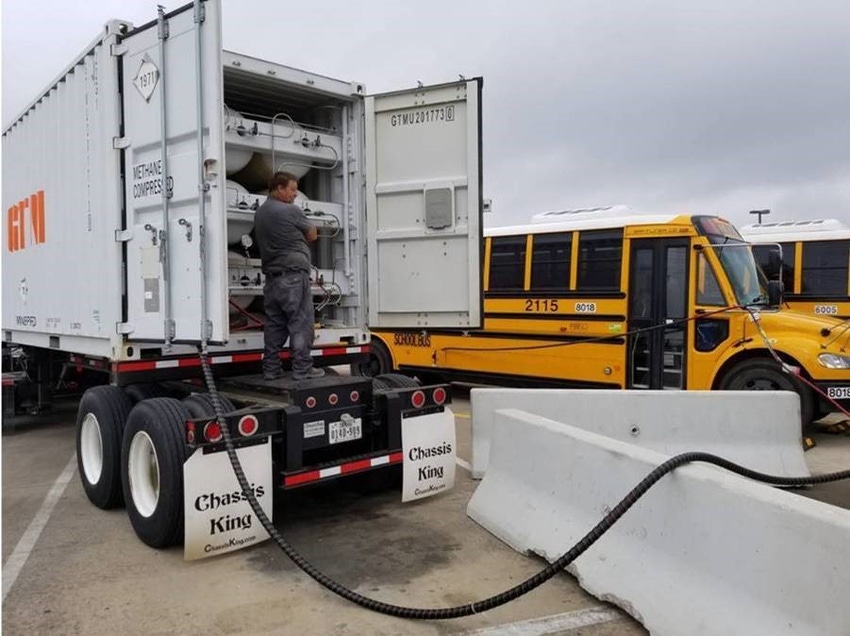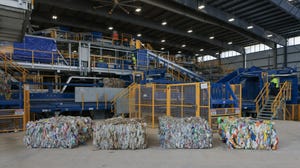Why Some Landfills are Exploring Virtual Pipelines to Capitalize on Gas
Although it’s an expensive endeavor, it may be worth it for remote landfills wanting to capitalize on renewable credits.

Bulk transportation of renewable natural gas (RNG) by truck, or a virtual pipeline, is a growing industry in the U.S. While some landfill owners are setting up virtual pipelines to fuel their fleets, a few are tapping into these systems to get gas into utility pipelines. It’s an expensive endeavor but may be worth it, especially for remote landfills wanting to capitalize on renewable credits. Some utilities find it’s opening opportunities for them, too.
Hexagon Lincoln in Nebraska manufactures mobile pipeline gas transportation modules, delivering about 500 of them throughout North America.
“We have seen gas products from agriculture waste in particular moving,” says Mark Babcock, director of business development for Hexagon Lincoln.
Still, for disposal sites especially, “adoption of this alternative way to reach pipeline has been slow because most opportunities for landfills are built around traditional models where gas is injected directly in the pipeline. But we want businesses to realize there are other methods to move gas into the pipeline,” he says.
Landfill operators showing interest are looking to monetize their gas by tapping into Renewable Identification Numbers (RINS) and the Low-Carbon Fuel Standard.
Utilities looking to lower their carbon footprint and meet renewable fuel obligations will pay an interstate pipeline company to move gas to a city gate where it comes from an interstate pipeline into the utility. Alternatively, utilities could use mobile pipeline to directly inject into their distribution system rather than take it from a transmission pipeline, explains Babcock.

Liberty Utilities in New Hampshire plans to source landfill gas in Bethlehem, N.H., and transport it via mobile pipeline to Keene, N.H.
“Using waste gas to provide low-cost, green energy makes sense for the environment and helps provide price stability for our customers,” says John Shore, Liberty Utilities spokesman. “Meanwhile, many landfills are not connected to or in proximity of local pipeline infrastructure, which makes the virtual pipeline an important tool in expanding landfill RNG potential. We believe this is a growing sector of natural gas utility service, and we look forward to working with other landfill operators and other parties to continue the development of this renewable resource.”
Hexagon Lincoln works with both project developers that want to monetize their gas streams and utility groups looking to source gas from other locations. Each has different questions, says Babcock.
Gas project developers may be concerned about cost to clean, compress and transport their product and then inject it into the distribution system. The utility may be concerned about cost but is more focused on processes and equipment to move the product safely.
Virtual systems only make sense when the pipeline is too far from where gas is produced, says McClain Porter, president of Catalyst RNG, which is based in Lexington, Ky.
Catalyst takes on roles from producing gas to delivering it to pipeline.

“To date, we have not been involved in virtual pipeline, as the general consensus is it’s too expensive. But we are starting to look at different ways to make the economics work. For example, by evaluating a virtual pipeline concept where we would group three projects into one,” says Porter.
There would be one common injection point to interconnect and one hauler utilizing large trucks to reduce trips per week.
“We are starting to look at virtual pipeline because we try and focus on smaller landfills. You have to get creative to put some of these smaller, remote sites on the map for potential developments,” says Porter.
Before it’s transported, biogas is compressed from between 100 and 150 pounds per square inch (psi) to about 3,600 psi. It is decompressed upon delivery.
“The ability of decompression equipment is critical because as one trailer depletes, another one has to come online to maintain a continuous flow of gas,” says Babcock.
Logistics and monitoring to ensure timely delivery are complex. Mobile pipeline operators typically have software that monitors volumes dispensed, pressure and temperature of gas remaining in trailers to predict how long available gas will maintain the system.
Kelley GTM makes high-pressure gas cylinders and assembles them into gas transport modules. It cleans the gas, compresses it to about 4,000 psi, puts it in containers and transports it to a pipeline interconnect or direct to end users—whether fleets or power plants.
Kelley GTM works with producers in agriculture and has a few landfill clients. The company is currently in early stages of developing landfill gas projects in Puerto Rico.
“With our model, we pay for gas and a percentage of the tax credits,” says Ken Kelley, CEO of Kelley GTM. “Everything comes down to economics. We think we can monetize landfill gas profitably.”
About the Author(s)
You May Also Like




